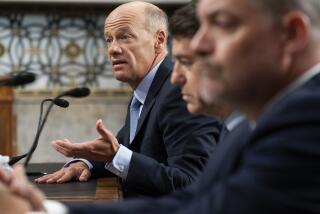Former Citigroup chief backs breakup of banking giants
- Share via
WASHINGTON — The crowd that wants to break up the biggest banks in the wake of the financial crisis has a new member: a former big banker.
Sanford “Sandy” Weill, who helped build Citigroup Inc. into one of the nation’s largest financial institutions, shocked many people when he said that investment banking should be separated from traditional banking.
“I think what we should probably do is go and split up investment banking from banking,” Weill said on CNBC’s “Squawk Box” on Wednesday. “Have banks be deposit takers. Have banks make commercial loans and real estate loans.
“And have banks do something that’s not going to risk the taxpayer dollars, that’s not going to be too big to fail.”
Host Becky Quick asked Weill if he was really suggesting the “pretty radical idea” of breaking up the biggest banks.
“That’s exactly what I am suggesting,” said Weill, who stepped down as chief executive of Citigroup in 2003 and as chairman in 2006.
Weill would like to reinstate a version of the 1933 Glass-Steagall Act, which prohibited deposit-taking banks from also operating as investment banks. Regulators began loosening the law’s limits in the late 1970s, and Congress fully repealed it in 1999.
Reaction to his comments came swiftly.
“The sheer irony of it is breathtaking,” said Russell Goldsmith, chief executive of City National Bancorp in Los Angeles, a regional bank with no investment-banking operations. “Sandy Weill is the guy that merged insurance and investment banking with Citibank in advance of Glass-Steagall being repealed. His was the crowning blow that tore the lid off Glass-Steagall.”
But Goldsmith said that he did not believe that merely separating commercial banks from investment banks would have averted the financial crisis or that it would prevent another meltdown.
“Look where the primary culprits were. Lehman Bros. and Bear Stearns were independent investment banks, operating as if Glass-Steagall was in place,” Goldsmith said.
Dominic Ng, chief executive of East West Bancorp of Pasadena, said he didn’t want large banks broken up by lawmakers or regulators. But boards of the those banks and their shareholders should consider the risk and oversight problems of being so large.
“Some of these banks are simply too big to manage today,” Ng said.
Since the financial crisis and the bailouts that followed -- including that of Citigroup -- many critics have blamed the repeal of Glass-Steagall for allowing some banks to become “too big to fail.” Some in Congress have been pushing to reinstate a prohibition on banks with deposits insured by the Federal Deposit Insurance Corp. from underwriting or investing in stocks.
Others have called for new limits on the size of banks to reduce the possibility that a future bank crisis could threaten the economy. Sen. Sherrod Brown (D-Ohio), for example, has been pushing legislation that, among other things, would limit a bank from having more than 10% of the total insured deposits in the U.S.
“Sanford Weill is one of many banking industry experts who have observed that too big to fail is often too big to manage,” Brown said.
Treasury Secretary Timothy F. Geithner declined to comment specifically on Weill’s statements.
--
scott.reckard@latimes.com
More to Read
Inside the business of entertainment
The Wide Shot brings you news, analysis and insights on everything from streaming wars to production — and what it all means for the future.
You may occasionally receive promotional content from the Los Angeles Times.











